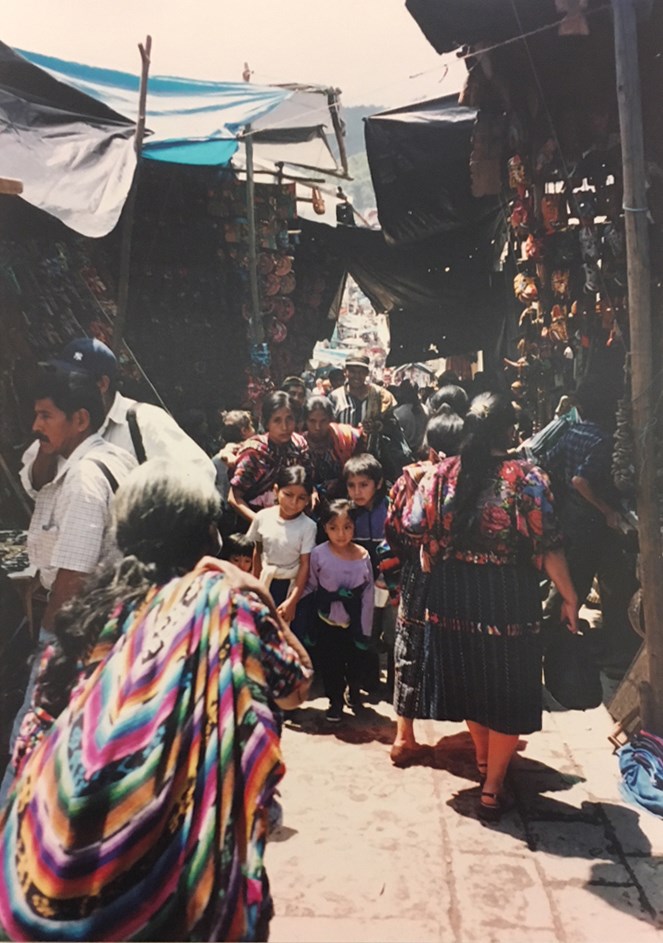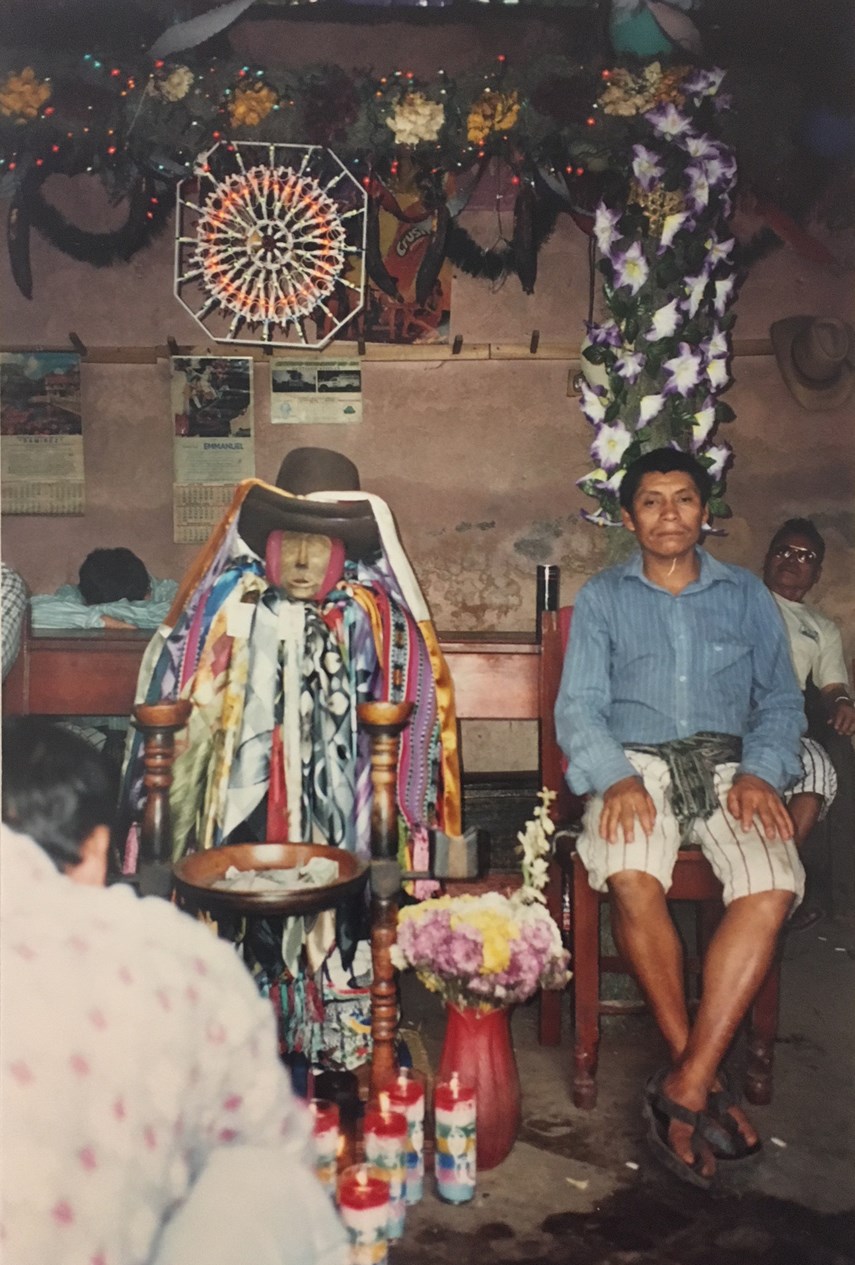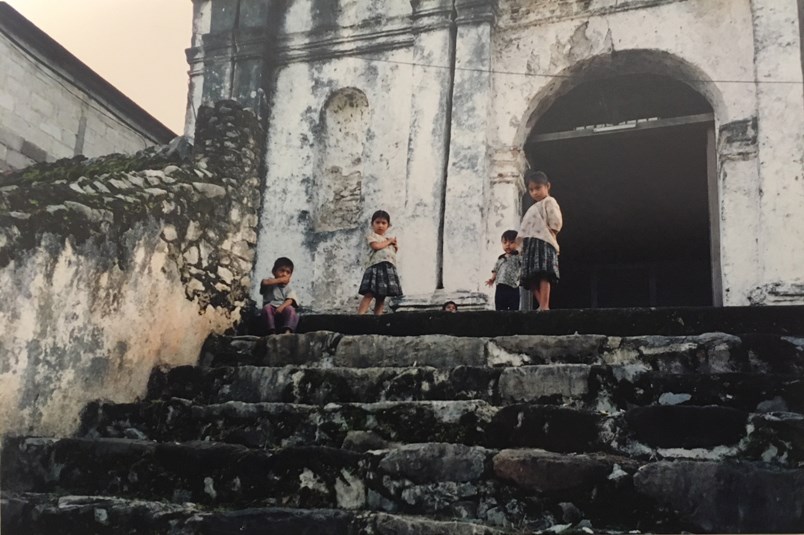IN the courtyard a shaman keeps feeding the gods.
A young family of four kneel in prayer as he throws rum and other liquids over an open fire. They are part of the ceremony but around them life goes on as usual. At times the shaman interrupts his incantations to take a swig from a 7-Up bottle on the other side of the fire. Everything is sacred in the Mayan world -- some things are just more sacred than others. Closer to the gods.
The living Maya are the direct descendants of a sophisticated culture that originated in southern Mexico and northern Central America over 2,000 years ago. Their achievements in science, art and social development rank with the great ancient civilizations of Egypt, Persia and Greece. They built complex city-states with a privileged noble class ruling over a hierarchical society of artisans and farmers. During the classic period (A.D. 250-900) the Maya empire stretched from Mexico’s Yucatan to northern Honduras.
No one knows exactly why the civilization declined more than a millennium ago but the best current theories suggest that the urban centres grew to a point where they were no longer able to support the population. Drought, famine and other factors all contributed to a systemic collapse of the Mayan world. By the time the Spanish arrived in the 16th century Tikal and other ancient Maya cities had already been reclaimed by the jungle.
Today Guatemala holds the highest concentration of Maya with approximately six million people linked to the indigenous culture (in Guatemala, southern Mexico and the Yucatán Peninsula, Belize, El Salvador, and western Honduras). The majority of them live in the highlands despite the constant threat of earthquakes and volcanic eruptions. The North American, Caribbean and Pacific tectonic plates converge in the region which is defined by a string of volcanoes to the south that tower over a varied terrain of pine forests, windswept plateaux and fertile valleys.
There is actually only one “city-state” in the area and that is Ciudad de Guatemala (Guatemala City) which has grown to a population of over three million -- most of that in just the past few decades. The second largest city, Quetzaltenango, has 125,000 people. Other than that, the densely-populated highlands are made up of villages and towns in a primarily rural agricultural area. Guatemala City has the same sort of relationship to the highlands as Calgary does to the Rockies -- it acts as a gateway to the region.

The highlands have been settled for millennia with the pre-classic Kaminaljuyu, now within the municipal limits of present-day Guatemala City, already an important ceremonial centre at the beginning of the Christian era. Archeologists are currently excavating the site to learn more. Another (post-classic) site is at Iximche, the ancient capital of the Cakchiquel Maya, established in 1470 and abandoned in 1524 after the Spanish arrived. But you don’t go to the highlands for the archeology, you go there to meet the living Maya.
Because the people were in the highlands, the Spanish came and built their towns over Mayan towns and their Catholic churches over Mayan temples. The contemporary highland culture continues to develop through several layers of history -- ancient Mayan villages gave way to Spanish colonial outposts that now have been reclaimed by the Indigenous population. There is a complex relationship at work that seems to become more muddled, the more you learn. For centuries the Maya have paid lip service to outside authority, operating in and around the colonial infrastructure while maintaining their own traditions.
The “museum town” of Antigua, the former Spanish capital for all of Central America, is the first major settlement one comes upon 45 kilometres west of Guatemala City. Antigua, named a UNESCO World Heritage Site in 1979, has had an unsettling history to say the least. It would probably still be the capital if not for a series of devastating earthquakes in the 18th century. One, on July 29, 1773, convinced the Spanish it was in their best interests to move and they set up a new government centre in Guatemala City.
Essentially Antigua is architecturally frozen in all its 18th century colonial splendour with the population of 30,000 living among ruins. Antigua has both historical and religious significance and is a favoured destination for many travellers. There is a wide range of accommodations available such as the Hotel Casa Santo Domingo, a former Dominican monastery, which has been converted into a hotel. Step outside into the hotel gardens and you are immediately transported back to the colonial era with the added drama of three volcanoes (Agua, Fuego and Acatenango) stationed on the horizon.
Despite repeated earthquakes a substantial number of historical buildings are still standing with many of them concentrated around the main plaza built in 1541. Today, the Plaza Mayor operates as Antigua’s central market with Mayan families selling fabrics and curios under shade trees. Some sellers arrive by horse and tether their animals to the side of the plaza while others bring their laundry and wash it in the town’s communal tubs. Ancient and modern customs coexist in colonial Antigua where everyday life is an other-worldly experience.
Moving deeper into the highlands traditional Mayan culture becomes even more dominant as you travel through the villages circling Lake Atitlan. Created from a volcanic eruption 80,000 years ago, the lake is 130 square kilometres and exceptionally deep -- up to 600 metres in places. Cakchiquel Maya live on the north shore of Lake Atitlan while Tzutuhil Maya reside in villages on the south side. Travellers must pass through the departmental centre of Solola before starting a steep descent towards the lake. San Francisco has nothing on the streets of Solola with the vertical drops a thrill for even the most jaded roller coaster aficionado.
While almost all highland women still wear traditional Mayan clothing, men have begun to adopt western styles. Few men in Antigua still wear traditional clothing whereas in Solola it’s not uncommon to see some still dressed in the colourful symbolism of their town. In Solola that includes a stylized bat motif identified with Cakchiquel lineage.
The best way to get around the lake is to start from Panajachel by boat -- some regions are not even accessible by car. Each village has its own distinct flavour with Panajachel (a.k.a. ‘Gringotenango’) the most touristy and with the most western amenities.
The Tzutuhil village Santiago Atitlan, directly across the lake from Panajachel at the foot of the Toliman volcano, is home to the cult of Maximon, a trickster god who relates both to the Mayan god Maam and the Christian Saint Simon. Pronounced ‘Mashimon’ the first part of this syncretic deity’s name is a Mayan word for tobacco. “Maximon usually appears in public with a big cigar between his lips -- just like the ancient Death Lords. To his followers Maximon is a great many things. He is the meeting of opposites, the soul of ambiguity,” says Ronald Wright in his study Time Among the Maya.

Until 1950 the wooden figure representing Maximon was kept by members of his Santiago brotherhood (Atiteco cofradias) in the rafters of a chapel. He was brought out on ceremonial occasions to be paraded through the streets.
Threatened by Maximon’s Mayan-ness, a visiting Catholic Action priest Padre Godofriedo and two accomplices broke into the church and stole the god. Maximon later turned up in Paris’ Musee de l’Homme and was not returned to Santiago Atitlan until 1978. “The French ambassador decided to return it in person. He put Maximon in a suitcase, rented a launch, and brought him across the lake chained to the wrist of a French woman diplomat in a business suit,” recounts Peter Canby in The Heart of the Sky (Travels Among the Maya).
Ever since then Maximon has been under the constant guard of his Atiteco cofradia. Every year he is moved to a new location in the village and is only brought out of the house during Holy Week. “On Good Friday Maximon is moved to a chapel near the Catholic church,” says Mayan tour guide Antonio Cuxil, a descendent of the Kaqchiquel Maya. “And as the Church has a procession with Jesus Christ through the streets Maximon is brought back to the house where he is kept.” Parallel processions with separate Mayan and Christian agendas.
The house where Maximon is kept is not a secret and most village children will lead visitors there for a few quetzals. This year Maximon has been set up in a non-descript cinder block house on a sidestreet in the village. When we visited the house a shaman was conducting a ritual ceremony in the open courtyard for a family of four. Behind them there were chairs set up against a wall and a small audience of villagers sat and watched the proceedings.
We arrived at 12:45 p.m. near the end of a four-hour ceremony. During the ritual the shaman continually fed the fire liquids and chanted. Off to the side was a one-room house which contained the figure of Maximon sitting in a chair surrounded by his Atiteco Cofradias. Guarding the doorway was a cofradia member wearing a T-shirt decorated with a hand-drawn skull on his chest. The house and courtyard were full of activity with a constant flow of villagers and tourists arriving to pay their respects to Maximon.
The cofradias are an important vestige of ancient customs and are the Guatemalan equivalent of the traditional cargo or burden of responsibility. “Cargo positions are sought after years in advance,” says Linda Schiele and David Freidel in The Forest of Kings (The Untold Story of the Ancient Maya). “To hold a cargo in the public life of a village is very expensive, often requiring most of the disposable income of a family and its relatives for many years. In this way, the accumulated wealth of families is put at the disposal of the entire community, and the men buy prestige and authority through their devotion.”
Moving north of Lake Atitlan to the Quiche village of Chichicastenango the fusion of the European and Mayan cultures becomes even more transparent. One of the reasons may be that although Catholic friars built a church here, they rarely came back to visit. They left the people to their own devices. In the grand scheme of things the village is very much a backwater except on Thursdays and Sundays when it hosts market days. On those occasions every inch of the centre part of town is taken up by sellers and their stalls.
Chichicastenango is one of the few places that still follows the ancient 260-day tzolkin calendar, albeit in parallel with the Christian calendar. The Spanish built the church of Santo Tomas in 1540 over the site of an ancient Mayan altar and only those unaware of its history would ever walk on the steps to reach the front door of the church. Shamans hold ceremonies on the sacred stairs and when one enters Santo Tomas through a side door, it’s obvious a lot of non-Christian ritual takes place inside as well. In all there are 12 altars set up through the centre of the colonial structure with the 13th altar being the steps themselves. In Santo Tomas Catholic mass and Mayan rituals can take place concurrently. It is the only such church where Mayan ritual is tolerated openly inside. While we were visiting Santo Tomas a woman shaman/priestess began to light candles on the ninth altar as preparation for a ceremony.
The Popul Vuh was written in Chichicastenango shortly after the Spanish arrived so the ancient ways wouldn’t be forgotten and all evidence suggests that won’t be happening soon.
(Originally published Nov., 2002)



